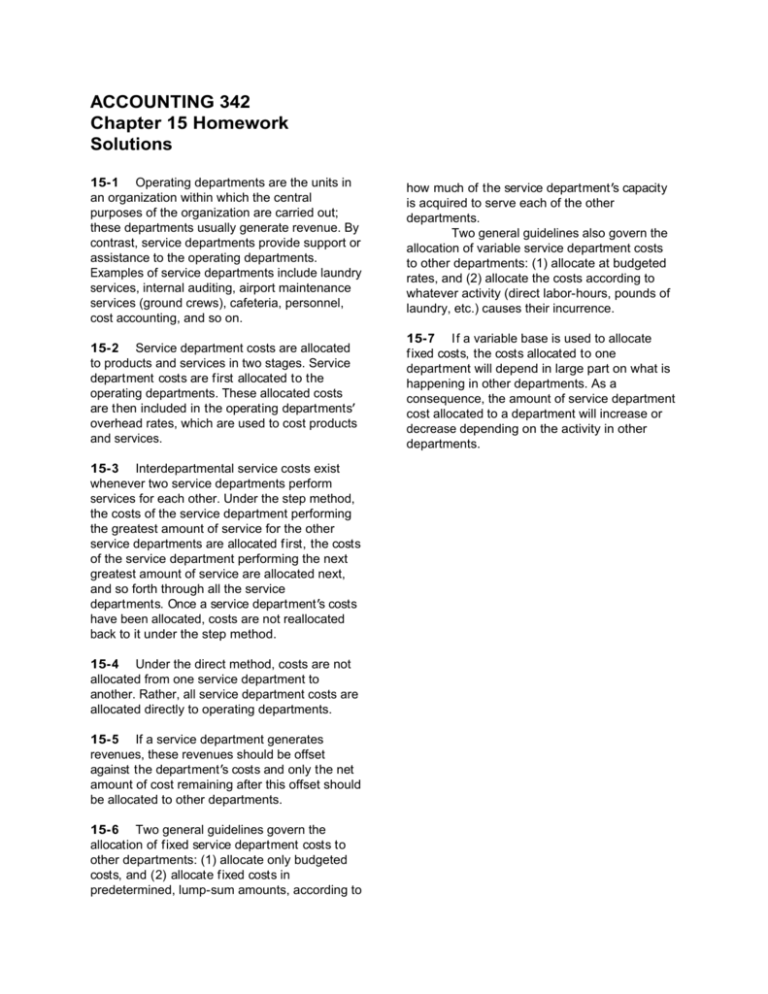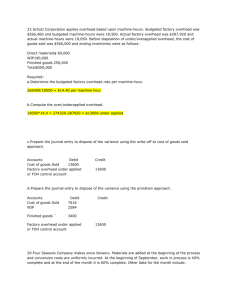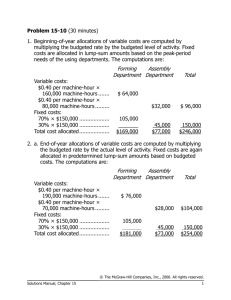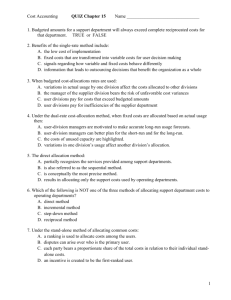
ACCOUNTING 342
Chapter 15 Homework
Solutions
15-1 Operating departments are the units in
an organization within which the central
purposes of the organization are carried out;
these departments usually generate revenue. By
contrast, service departments provide support or
assistance to the operating departments.
Examples of service departments include laundry
services, internal auditing, airport maintenance
services (ground crews), cafeteria, personnel,
cost accounting, and so on.
how much of the service department s capacity
is acquired to serve each of the other
departments.
Two general guidelines also govern the
allocation of variable service department costs
to other departments: (1) allocate at budgeted
rates, and (2) allocate the costs according to
whatever activity (direct labor-hours, pounds of
laundry, etc.) causes their incurrence.
15-2 Service department costs are allocated
to products and services in two stages. Service
department costs are first allocated to the
operating departments. These allocated costs
are then included in the operating departments
overhead rates, which are used to cost products
and services.
15-7 If a variable base is used to allocate
fixed costs, the costs allocated to one
department will depend in large part on what is
happening in other departments. As a
consequence, the amount of service department
cost allocated to a department will increase or
decrease depending on the activity in other
departments.
15-3 Interdepartmental service costs exist
whenever two service departments perform
services for each other. Under the step method,
the costs of the service department performing
the greatest amount of service for the other
service departments are allocated first, the costs
of the service department performing the next
greatest amount of service are allocated next,
and so forth through all the service
departments. Once a service department s costs
have been allocated, costs are not reallocated
back to it under the step method.
15-4 Under the direct method, costs are not
allocated from one service department to
another. Rather, all service department costs are
allocated directly to operating departments.
15-5 If a service department generates
revenues, these revenues should be offset
against the department s costs and only the net
amount of cost remaining after this offset should
be allocated to other departments.
15-6 Two general guidelines govern the
allocation of fixed service department costs to
other departments: (1) allocate only budgeted
costs, and (2) allocate fixed costs in
predetermined, lump-sum amounts, according to
Problem 15- 10
1.
(Thousands of ¥)
Factory
Administration
Custodial
Services Personnel
Maintenance
Machining Assembly
Step method
Operating department costs ......
¥376,300
Costs to be allocated ................ ¥270,000 ¥ 68,760 ¥ 28,840 ¥ 45,200
Allocations:
Factory Administration
@ ¥1,800 per labor-hour ..... (270,000)
5,400
9,000
39,600
54,000
Custodial Services
@ ¥720 per square foot. ......
(74,160)
2,160
7,200
50,400
Personnel
@ ¥320,000 per employee ...
(40,000)
8,000
12,800
Maintenance
@ ¥1,250 per machinehour...................................
(100,000)
87,500
Total overhead after
allocations............................. ¥
0 ¥
0 ¥
0 ¥
0 ¥581,000
Divide by machine-hours
(thousands) ..........................
70
Divide by direct labor-hours
(thousands) ..........................
Overhead rate..........................
¥ 8,300
¥175,900
162,000
14,400
19,200
12,500
¥384,000
80
¥ 4,800
© The McGraw-Hill Companies, Inc., 2006. All rights reserved.
Solutions Manual, Chapter 15
2
Problem 15- 10 (continued)
2.
(Thousands of ¥)
Factory
Administration
Direct method
Operating department costs ......
Costs to be allocated ................ ¥270,000
Allocations:
Factory Administration
(1/4, 3/4) ........................... (270,000)
Custodial Services (7/9, 2/9)...
Personnel (2/5, 3/5)...............
Maintenance (7/8, 1/8) ..........
Total overhead after
allocations............................. ¥
0
Divide by machine-hours
(thousands) ..........................
Divide by direct labor-hours
(thousands) ..........................
Overhead rate..........................
Custodial
Services Personnel
¥68,760
¥28,840
Maintenance
Machining Assembly
(28,840)
(45,200)
0
¥
0
¥175,900
67,500
53,480
11,536
39,550
202,500
15,280
17,304
5,650
¥548,366
¥416,634
¥45,200
(68,760)
¥
¥376,300
¥
0
70
¥ 7,834 ¥
80
5,208
© The McGraw-Hill Companies, Inc., 2006. All rights reserved.
Solutions Manual, Chapter 15
3
Problem 15- 10 (continued)
3. Plantwide rate
Overhead rate=
=
Total overhead cost
Total direct labor-hours
¥965,000,000
= ¥9,650 per DLH
100,000 DLHs
4. The amount of overhead cost assigned to the job would be:
Step method:
Machining Department: ¥8,300 per machine-hour ×
190 machine-hours................................................. ¥1,577,000
Assembly Department: ¥4,800 per direct labor-hour
× 75 direct labor-hours ...........................................
360,000
Total overhead cost ..................................................... ¥1,937,000
Direct method:
Machining Department: ¥7,834 per machine-hour ×
190 machine-hours................................................. ¥1,488,460
Assembly department: ¥5,208 per direct labor-hour ×
75 direct labor-hours ..............................................
390,600
Total overhead cost ..................................................... ¥1,879,060
Plantwide method:
¥9,650 per direct labor-hour × 100 direct labor-hours.. ¥ 965,000
The plantwide method, which is based on direct-labor hours, assigns
very little overhead cost to the job since it requires little labor time.
Assuming that Factory Administrative costs really do vary in proportion
to labor-hours, Custodial Services with square feet occupied, and so on,
the company will tend to undercost such jobs if a plantwide overhead
rate is used (and it will tend to overcost jobs requiring large amounts of
labor time). The direct method is better than the plantwide method, but
the step method will generally provide the most accurate overhead rates
of the three methods.
© The McGraw-Hill Companies, Inc., 2006. All rights reserved.
Solutions Manual, Chapter 15
Problem 15- 11
1.
Auto
Division
Variable costs:
$3 per meal × 35,000 meals..... $105,000
$3 per meal × 20,000 meals.....
Fixed costs:
65% × $40,000.......................
26,000
35% × $40,000.......................
Total cost allocated..................... $131,000
Truck
Division
$60,000
14,000
$74,000
The variable costs are allocated by multiplying the budgeted rate per
meal by the budgeted number of meals that will be served in each
division during the month. The fixed costs are allocated in
predetermined, lump-sum amounts based on the peak-period need for
meals in each division.
2.
Auto
Division
Variable costs:
$3 per meal × 20,000 meals.....
$3 per meal × 20,000 meals.....
Fixed costs:
65% × $40,000.......................
35% × $40,000.......................
Total cost allocated.....................
Truck
Division
$60,000
$60,000
26,000
$86,000
14,000
$74,000
The variable costs are allocated according to the budgeted rate per meal
and not according to the actual rate. The fixed costs are again allocated
in predetermined, lump-sum amounts, based on budgeted fixed costs.
Any difference between budgeted and actual costs is not allocated, but
rather is treated as a spending variance of the cafeteria:
Total actual costs for the month................
Total cost allocated above ........................
Spending variance not allocated .............
Variable
$128,000
120,000
$ 8,000
Fixed
$42,000
40,000
$ 2,000
© The McGraw-Hill Companies, Inc., 2006. All rights reserved.
Solutions Manual, Chapter 15
Problem 15- 11 (continued)
3. Actual variable costs..............
Actual f ixed costs..................
Total actual costs ..................
$128,000
42,000
$170,000
One-half of the cost, or $85,000, would be allocated to each division,
since an equal number of meals were served in each division during the
month.
4. This method has two major problems. First, the spending variances
should not be allocated, since this forces the inefficiencies of the service
department onto the using departments. Second, the fixed costs should
not be allocated according to month-by-month usage of services, since
this causes the allocation to one division to be affected by what happens
in another division.
5. Their strategy probably will be to underestimate their peak period
requirements in order to force a greater proportion of any allocation
onto other departments. Top management can control ploys of this type
by careful follow-up, with rewards being given to those managers who
estimate accurately, and severe penalties assessed against those
managers who underestimate their peak period requirements. For
example, departments whose managers underestimate their peak period
requirements may be denied access to the cafeteria once their estimates
have been exceeded.
© The McGraw-Hill Companies, Inc., 2006. All rights reserved.
Solutions Manual, Chapter 15
Problem 15- 12
1. Yes, there is merit to the complaint. The company is using a variable
base (hours of hangar use) to allocate costs that are largely fixed. Thus,
the amount of cost that is charged to a division during a given month
will depend to a large extent on usage in other divisions. A reduction in
usage in one division can result in shifts of costs from it onto the other
divisions, even though the other divisions receive no more service.
2.
1st quarter activity ...............
2nd quarter activity ..............
Difference............................
Variable cost element =
=
Hours of Use
3,000
2,000
1,000
Total Cost
$172,000
168,000
$ 4,000
Change in cost
Change in activity
$4,000
= $4 per hour
1,000 hours
Fixed cost per quarter:
Total cost, 1st quarter................................................
Less variable cost ($4 per hour × 3,000 hours)............
Fixed cost .................................................................
$172,000
12,000
$160,000
Thus, the cost formula is $160,000 f ixed cost plus $4 per hour variable
cost.
© The McGraw-Hill Companies, Inc., 2006. All rights reserved.
Solutions Manual, Chapter 15
Problem 15- 12 (continued)
3. Even though the peak-period level of activity will not be reached until
the fourth quarter, it should still be used to allocate the fixed costs of
the hangar. The reason is that peak-period requirements determine the
present level of fixed costs. The fact that the divisions do not need a
peak-period level of servicing every quarter is immaterial. If the divisions
require such servicing at certain times, then the capacity to deliver it
must be available, and it is the responsibility of the divisions to bear the
cost of that capacity.
Domestic Overseas
Freight Passenger Passenger
1st quarter allocation:
Variable cost:
$4 per hour × 900 hours ................. $ 3,600
$4 per hour × 1,800 hours...............
$4 per hour × 300 hours .................
Fixed cost:
30% × $160,000 ............................ 48,000
50% × $160,000 ............................
20% × $160,000 ............................
Total cost allocation ........................... $51,600
2nd quarter allocation:
Variable cost:
$4 per hour × 800 hours ................. $ 3,200
$4 per hour × 700 hours .................
$4 per hour × 500 hours .................
Fixed cost:
30% × $160,000 ............................ 48,000
50% × $160,000 ............................
20% × $160,000 ............................
Total cost allocation ........................... $51,200
$ 7,200
$ 1,200
80,000
$87,200
32,000
$33,200
$ 2,800
$ 2,000
80,000
$82,800
32,000
$34,000
© The McGraw-Hill Companies, Inc., 2006. All rights reserved.
Solutions Manual, Chapter 15
Problem 15- 14
1. Beginning-of-year allocations of variable costs are computed by
multiplying the budgeted rate by the budgeted level of activity. Fixed
costs are allocated in lump-sum amounts based on the peak-period
needs of the using departments. The computations are:
Forming
Assembly
Department Department
Variable costs:
$0.40 per machine-hour ×
160,000 machine-hours .......
$0.40 per machine-hour ×
80,000 machine-hours .........
Fixed costs:
70% × $150,000 ...................
30% × $150,000 ...................
Total cost allocated...................
Total
$ 64,000
$32,000
$ 96,000
45,000
$77,000
150,000
$246,000
105,000
$169,000
2. a. End-of-year allocations of variable costs are computed by multiplying
the budgeted rate by the actual level of activity. Fixed costs are again
allocated in predetermined lump-sum amounts based on budgeted
costs. The computations are:
Forming
Assembly
Department Department
Variable costs:
$0.40 per machine-hour ×
190,000 machine-hours .......
$0.40 per machine-hour ×
70,000 machine-hours .........
Fixed costs:
70% × $150,000 ...................
30% × $150,000 ...................
Total cost allocated...................
Total
$ 76,000
$28,000
$104,000
45,000
$73,000
150,000
$254,000
105,000
$181,000
© The McGraw-Hill Companies, Inc., 2006. All rights reserved.
Solutions Manual, Chapter 15
Problem 15- 14 (continued)
b. Any difference between the budgeted and actual variable cost per
machine-hour or between the budgeted and actual total fixed cost
would not be allocated to the other departments. The amount not
allocated would be:
Actual cost incurred during the year...
Cost allocated (above) ......................
Cost not allocated (spending
variance).......................................
Variable
Fixed
Cost
Cost
Total
$110,000 $153,000 $263,000
104,000 150,000 254,000
$ 6,000 $ 3,000 $ 9,000
The costs not allocated are spending variances of the Maintenance
Department and are the responsibility of the Maintenance
Department s manager.
© The McGraw-Hill Companies, Inc., 2006. All rights reserved.
Solutions Manual, Chapter 15





